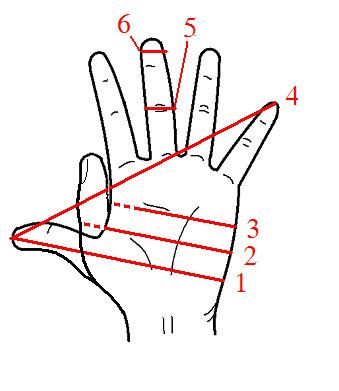 | ||
The palm is an obsolete anthropic unit of length, originally based on the width of the human palm and then variously standardized. The same name is also used for a second, rather larger unit based on the length of the human hand.
Contents
The width of the palm was a traditional unit in Ancient Egypt, Israel, Greece, and Rome and in medieval England, where it was also known as the hand, handbreadth, or handsbreadth. The only commonly discussed "palm" in modern English is the biblical palm of ancient Israel.
The length of the hand—originally the Roman "greater palm"—formed the palm of medieval Italy and France.
The Spanish and Portuguese "palm" (palmo or palmo de craveira) was the span, the distance between an outstretched thumb and little finger.
Ancient Egypt
The Ancient Egyptian palm (Egyptian: shesep) has been reconstructed as about 75 mm or 3 in. The unit is attested as early as the reign of Djer, third pharaoh of the First Dynasty, and appears on many surviving cubit-rods.
The palm was subdivided into four digits (djeba) of about 19 mm (0.75 in).
Three palms made up the span (pedj) or lesser span (pedj-sheser) of about 22.5 cm (9 in). Four palms made up the foot (djeser) of about 30 cm (1 ft). Five made up the remen of about 37.5 cm (1 ft 3 in). Six made up the "Greek cubit" (meh nedjes) of about 45 cm (1 ft 6 in). Seven made up the "royal cubit" (meh niswt) of about 52.5 cm (1 ft 9 in). Eight made up the pole (nbiw) of about 60 cm (2 ft).
Ancient Israel
The palm was not a major unit in ancient Mesopotamia but appeared in ancient Israel as the tefah, tepah, or topah (Hebrew: טפח, lit. "a spread"). Scholars were long uncertain as to whether this was reckoned using the Egyptian or Babylonian cubit, but now believe it to have approximated the Egyptian "Greek cubit", giving a value for the palm of about 74 mm or 2.9 in.
As in Egypt, the palm was divided into four digits (etzba or etsba) of about 18.5 mm (0.73 in) and three palms made up a span (zeret) of about 22.1 cm (9 in). Six made up the Hebrew cubit (amah or ammah) of about 44.3 cm (1 ft 5 in), although the cubits mentioned in Ezekiel follow the royal cubit in consisting of seven palms comprising about 51.8 centimeters (1 ft 8 in).
Ancient Greece
The Ancient Greek palm (Greek: παλαιστή, palaistḗ, δῶρον, dō̂ron, or δακτυλοδόχμη, daktylodókhmē) made up ¼ of the Greek foot (poûs), which varied by region between 27–35 cm (11 in–1 ft 2 in). This gives values for the palm between 6.7–8.8 cm (2.6–3.5 in), with the Attic palm around 7.4 cm (2.9 in).
These various palms were divided into four digits (dáktylos) or two "middle phalanges" (kóndylos). Two palms made a half-foot (hēmipódion or dikhás); three, a span (spithamḗ); four, a foot (poûs); five, a short cubit (pygōn); and six, a cubit (pē̂khys).
The Greeks also had a less common "greater palm" of five digits.
Ancient Rome
The Roman palm (Latin: palmus) or lesser palm (palmus minor) made up ¼ of the Roman foot (pes), which varied in practice between 29.2–29.7 cm (11.5–11.7 in) but is thought to have been officially 29.6 cm (11.7 in). This would have given the palm a notional value of 7.4 cm (2.9 in) within a range of a few millimeters.
The palm was divided into four digits (digitus) of about 1.85 cm (0.7 in) or three inches (uncia) of about 2.47 cm (1.0 in). Three made a span (palmus maior or "greater palm") of about 22.2 cm (9 in); four, a Roman foot; five, a hand-and-a-foot (palmipes) of about 37 cm (1 ft 3 in); six, a cubit (cubitus) of about 44.4 cm (1 ft 5.5 in).
Continental Europe
The palms of medieval (Latin: palma) and early modern Europe—the Italian, Spanish, and Portuguese palmo and French palme—were based upon the Roman "greater palm", reckoned as a hand's span or length.
In Italy, the palm (Italian: palmo) varied regionally. The Genovese palm was about 24.76–24.85 cm (9.7–9.8 in); in the Papal States, the Roman palm about 21.05 cm (8.3 in) according to Hutton but divided into the Roman "architect's palm" (palmo di architetti) of about 22.32 cm (8.8 in) and "merchant's palm" (palmo del braccio di mercantia) of about 21.21 cm (8.4 in) according to Greaves; and the Neapolitan palm reported as 20.31 cm (8.0 in) by Riccioli but 21.80 cm (8.6 in) by Hutton's other sources. On Sicily and Malta, it was 24.61 cm (9.7 in).
In France, the palm (French: palme or pan) was about 24.61 cm (9.7 in) in Pernes-les-Fontaines, Vaucluse, and about 24.76 cm (9.7 in) in Languedoc.
Palaiseau gave metric equivalents for the palme or palmo in 1816, and Rose provided English equivalents in 1900:
England
The English palm, handbreadth, or handsbreadth is three inches (7.62 cm) or, equivalently, four digits. The measurement was, however, not always well distinguished from the hand or handful, which became equal to four inches by a 1541 statute of Henry VIII. The palm was excluded from the British Weights and Measures Act of 1824 that established the imperial system and is not a standard US customary unit.
Elsewhere
The Moroccan palm is given by Hutton as about 18.20 cm (7.2 in).
